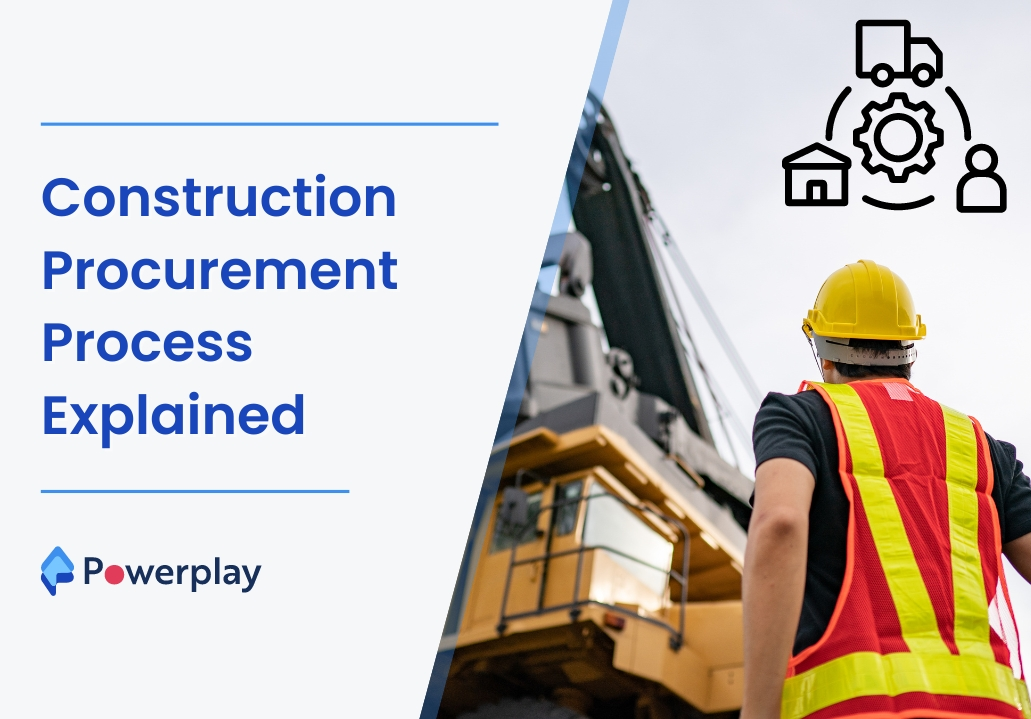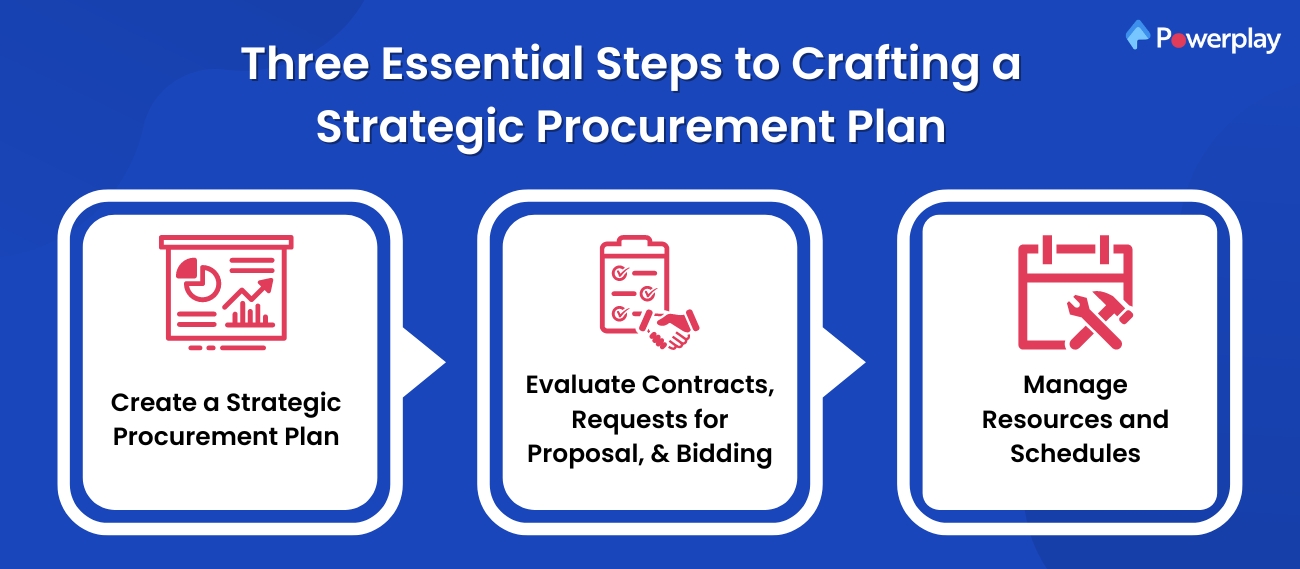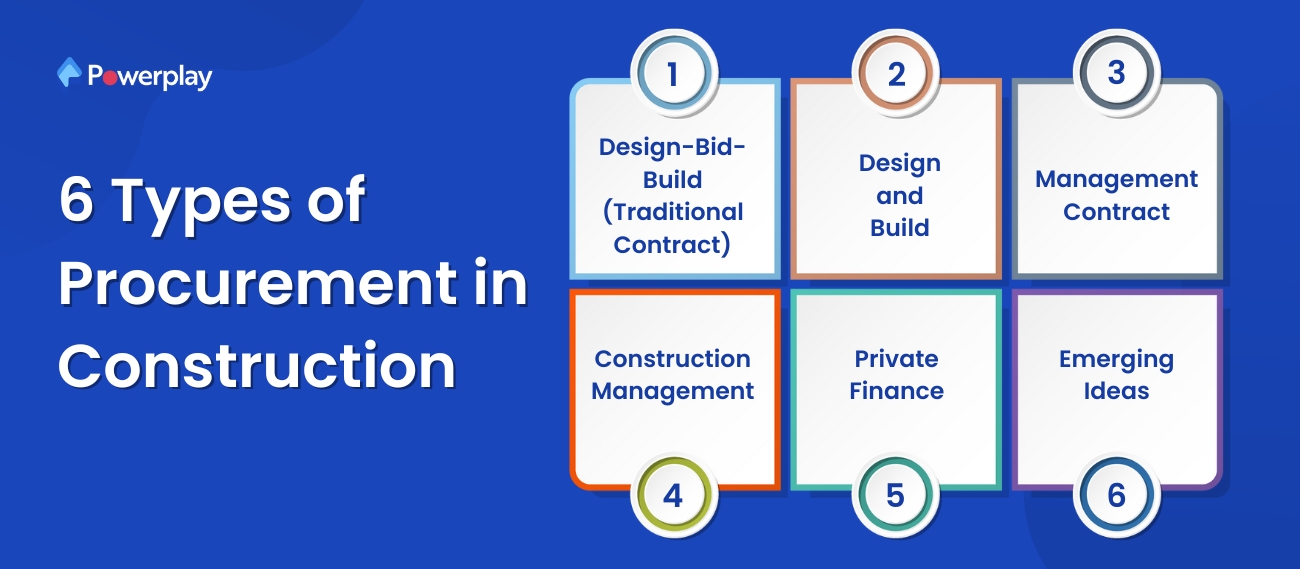Construction Procurement Process Explained
-
Sapna
- May 3, 2024

From sprawling commercial complexes to cosy home renovations, procurement plays a pivotal role in the triumph of every construction project. For professionals in the building industry, the focus extends beyond simply gathering materials and adhering to timelines—it centres on enhancing profitability. A lack of organisation can fragment essential project information and generate unnecessary “Gray Work” that impedes efficiency.

How companies structure their procurement teams and the technology they implement to oversee this crucial process can significantly impact the overall costs of construction projects.
This blog will guide you through the various procurement methods used in the construction industry and offer valuable best practices to help you establish an optimal system for your business.
Table of Contents
What is the construction procurement process?
The construction procurement process encompasses the systematic approach to acquiring goods and services required for a construction project. It involves various stages, including identifying project needs, soliciting bids or proposals from potential suppliers or contractors, evaluating offers, selecting the most suitable candidate, and negotiating contracts.
Additionally, it may involve establishing terms and conditions, managing vendor relationships, and ensuring compliance with regulations and standards. This process aims to secure the necessary resources, achieve project objectives within budget and time constraints, and mitigate risks associated with construction projects, ensuring efficiency, quality, and successful project completion.
Benefits of the Construction Project Procurement

The construction project procurement process offers several benefits, such as:
Cost Efficiency:
By soliciting competitive bids or proposals, construction project procurement helps secure the most cost-effective solutions, ensures optimal resource allocation, and minimises project expenses.
Quality Assurance:
Procurement processes help ensure that contractors and suppliers meet predefined quality standards through rigorous evaluation and selection criteria, enhancing the overall quality of construction projects.
Risk Management:
Effective procurement strategies help identify and mitigate potential risks associated with construction projects by selecting reliable contractors, establishing clear contract terms, and implementing risk mitigation measures.
Timely Delivery:
Proper procurement planning and management facilitate the timely acquisition of materials, equipment, and services, ensuring project schedules are met and deadlines are achieved.
Transparency and Accountability:
Transparent procurement processes promote fairness, integrity, and accountability in project execution, fostering stakeholder trust and minimising the likelihood of disputes or conflicts.
Who is responsible for construction project procurement?
In construction projects, procurement typically falls on the project manager and the procurement or purchasing department if the organisation is large enough to have one. Smaller companies might handle these responsibilities directly by the project manager or the owner.

Create a Strategic Procurement Plan
A strategic procurement plan is crucial for the success of a construction project. This plan involves identifying project needs, defining procurement policies, setting timelines, and allocating budgets.
The goal is to align procurement activities with the overall project objectives and timeline, ensuring that all necessary materials and services are procured efficiently and effectively. This planning phase includes market research, supplier evaluation, and the development of a risk management strategy to handle potential challenges in the supply chain.
Evaluate Contracts, Requests for Proposal, and Bidding
Evaluating contracts and managing the request for proposal (RFP) and bidding processes are central to effective procurement. This involves drafting clear and detailed RFPs that outline the project requirements and criteria for selection.
The procurement team reviews bids from contractors and suppliers, assessing them based on price, capability, experience, and compliance with the RFP. The goal is to select vendors that offer the best value for money while meeting the project’s specifications and quality standards.
Manage Resources and Schedules
Effective resource and schedule management is critical to ensuring that procurement does not become a bottleneck in the construction process. This includes coordinating the timely delivery of materials and equipment and ensuring that labour resources are available when needed.
The procurement team must work closely with the project scheduler or planning team to integrate procurement timelines with the project schedule. This coordination helps prevent delays and ensures the project progresses according to plan.
What Are the Types of Procurement in Construction?

Design-Bid-Build (or Traditional Contract)
In the Design-Bid-Build approach, the project owner first hires an architect or engineer for design the actual project. Once the design is complete, the owner seeks bids from contractors to construct the project based on the provided design. The contractor with the lowest bid gets awarded with contract. This method clearly separates the design and construction phases, allowing for competitive bidding and lower construction costs.
Design and Build
Design-and-build procurement involves hiring a single entity, usually a design-build firm, to manage the project’s design and construction phases. This integrated approach fosters collaboration between designers and builders, streamlining the construction process and potentially reducing project delivery time and costs. Design-and-build contracts often emphasise innovation and value engineering to optimise project outcomes.
Management Contract
Under a Management Contract arrangement, the project owner appoints a construction manager to oversee the entire project, including the design, procurement, and construction phases.
They acts as an advisor to the owner, providing expertise in project planning, scheduling, and cost management. This procurement method offers greater flexibility and owner involvement throughout the project lifecycle, with the CM responsible for coordinating the work of various contractors and ensuring project objectives are met.
Construction Management
Construction Management procurement involves hiring a construction manager who provides advisory services during construction. Unlike Management Contracting, where the CM is involved from project inception, in Construction Management, the CM is typically engaged once the design is complete and construction begins. The CM assists the owner in selecting and managing subcontractors, monitoring project progress, and resolving construction-related issues, aiming to optimise project performance and quality.
Private Finance
Private Finance procurement, or Public-Private Partnerships (PPP) or Build-Operate-Transfer (BOT), involves private sector entities financing, designing, constructing, and often operating infrastructure projects. In this model, the private sector assumes significant project risks and responsibilities in exchange for revenue generated from the project over its lifecycle. Private Finance procurement can offer innovative funding solutions, accelerate project delivery, and transfer certain project risks to the private sector.
Emerging Ideas
In addition to traditional procurement methods, emerging ideas in construction procurement include collaborative approaches like Integrated Project Delivery (IPD), where stakeholders work together from project inception to completion, sharing risks and rewards. Other innovative models include Alliancing, where stakeholders form a single collaborative team, and Early Contractor Involvement (ECI), where contractors are engaged early in the design phase to provide input on constructability and cost optimisation. These emerging procurement ideas emphasise collaboration, innovation, and shared project objectives to improve project outcomes.
Procurement vs. Purchasing
The terms procurement and purchasing are often used interchangeably within various industries, including construction, but they encompass different aspects of the process related to acquiring goods and services.
Procurement
Purchasing is the transactional phase of procurement. It involves the actual buying of goods and services. This step is focused on executing the purchase: placing orders, receiving goods, paying invoices, and handling the administrative tasks associated with these actions. Purchasing is primarily concerned with the immediate, operational needs of the organisation.
Purchasing
Procurement involves a broader scope. It encompasses the strategic process of sourcing, negotiating, and planning, in addition to purchasing. Procurement aims not just to buy but to ensure that the purchase aligns with the strategic goals of the organisation. It includes selecting suppliers, negotiating contracts, strategic vetting, and establishing long-term relationships with vendors. Procurement also involves managing the overall life cycle of a product, including demand forecasting, specification development, value analysis, and disposal.
Steps in Construction Procurement
The construction procurement process is a critical component in executing construction projects. It involves selecting and acquiring construction materials and services essential for completing a project.

Here’s are the steps you need to follow:
1. The design team creates specifications.
This initial step involves the project’s design team, which usually includes architects and engineers, creating detailed specifications for the project. These specifications define the project requirements, including materials, standards, dimensions, and performance criteria. This document serves as a blueprint that ensures all stakeholders understand the project scope and requirements.
2. Contractors estimate and bid on the project.
Based on the specifications provided, contractors prepare and share their bids or proposals for the project. This involves estimating the cost of materials, labour, equipment, and overheads. The bid also includes a proposed timeline for project completion. Contractors use their expertise to offer competitive pricing and timelines in their bids to win the contract.
3. The owner and contractor agree to terms.
Once the bids are reviewed, the project owner or developer selects a contractor based on various criteria such as price, experience, proposed timeline, and submission quality. The chosen contractor and the owner then agree on terms which are formalised in a contract. This contract outlines the responsibilities, timelines, payment schedule, and legalities associated with the project.
4. Contractors solicit bids or pricing from suppliers.
After the contract is awarded, the contractor must acquire the materials and services necessary to complete the project. This often involves soliciting bids or pricing from various suppliers and subcontractors. The goal is to secure the best possible prices and ensure material availability according to the project schedule.
5. Contractors plan their procurement sequences.
Effective procurement sequence planning is crucial for managing the flow of materials and ensuring that resources are available when needed. This step involves scheduling the delivery of materials to coincide with the project phases. Proper planning helps avoid delays and minimises storage costs and material damage.
6. The design team reviews contractor submittals.
Contractor submittals include samples, product data, and other information the contractor provides to the design team for approval. This ensures that the materials and products being used in the construction meet the specified requirements and standards outlined in the initial specifications.
7. Contractors finalise the purchase with suppliers.
Once the submittals are approved, contractors finalise their orders with suppliers. This includes confirming quantities, delivery schedules, and prices. It may also involve negotiating terms and conditions related to payment, returns, and warranties.
8. Suppliers deliver materials and equipment to the job site.
Suppliers and subcontractors coordinate the delivery of materials, equipment, and other resources directly to the job site based on the agreed schedule. Timely delivery is critical to keep the project on track and prevent disruptions in the workflow.
9. Contractor work and materials pass final inspections.
As the construction progresses, various inspections are conducted to ensure that the work corresponds with building codes, safety standards, and the project specifications. Upon project completion, a final inspection is carried out to certify that all aspects of the construction meet the required standards. Passing these inspections is crucial for the project to receive the necessary certifications and approvals for occupancy or use.
Solving Common Procurement Challenges
The process of procurement is integral to the construction process, encompassing everything from initial planning to final installation. Effective procurement management is essential for reducing risks, and to manage budgets, while ensuring the overall quality of a project.
Ambiguous Specifications
Speciality contractors can minimise ambiguity by utilising requests for information (RFIs) before commencing procurement or submitting documents. This ensures the design team clearly understands and specifies all materials, such as specific plumbing fixtures and connections, thus avoiding misinterpretations and errors.
Submittal Delays
Streamlining the submittal process through enhanced communication systems from owners and design teams to procurement personnel is crucial. This coordination helps maintain quality control and minimise delays, facilitating a smoother project flow.
Budget Overruns
Efficient procurement management helps mitigate unexpected cost spikes and downtime, which can be costly. Ensuring competitive and transparent selection for each significant project component reduces rework and errors, thus maintaining budget control.
Supply Chain Disruption
Early prioritisation in the procurement process is vital for items with long lead times, such as major electrical components. This proactive approach reduces the impact of supply chain disruptions, ensuring that speciality contractors can complete their phases without delay.
Payment Delays
Speciality contractors often face tight cash flows, as they typically purchase materials on credit and may receive payments from general contractors after their suppliers’ deadlines. Effective cash flow management, including utilising financing options that align with billing cycles, is crucial for maintaining project liquidity.
Schedule Changes or Delays
Adapting to schedule changes is critical for keeping the project on track. Proper scheduling ensures that all necessary components are available when needed, minimising the likelihood of rework and helping to meet original specifications.
Design Changes
Contractors should secure approved change orders before procuring materials for any design alterations. Proceeding without proper approvals can introduce significant risks, particularly if the new components do not meet the owner’s criteria.
Damage to Stored Materials
The security measures must be in place to protect materials stored on-site or in warehouses. This includes safeguarding against theft, vandalism, and damage from environmental factors. Construction documents should specify which party is liable for any damage or theft, ensuring clear responsibilities.
Procurement management is risk management.
In construction procurement management acts as a form of risk management by strategically overseeing the acquisition of goods and services to mitigate potential risks. This process ensures that materials are sourced from reliable suppliers, minimising the chances of delays and quality issues.
It also involves negotiating favourable terms and conditions that protect the project against financial overruns. By proactively managing procurement activities, firms can reduce the risks associated with cost volatility, supply chain disruptions, and non-compliance with project specifications, safeguarding project timelines and budgets.
How Powerplay can help in construction procurement?
Powerplay is one of the best construction management software programs for enhancing procurement efficiency in construction projects. It offers various user-friendly features to streamline the procurement process, from vendor management to contract administration, ensuring timely and cost-effective purchasing.

Powerplay facilitates real-time communication and team document sharing, reducing delays and misunderstandings. Its integrated platform allows for comprehensive tracking of orders and deliveries, helping manage budgets and schedules effectively. Powerplay provides actionable insights by centralising procurement data, which helps enable better decision-making and ultimately improve project outcomes.
Conclusion
Mastering the construction procurement process is essential to achieve success of any construction project, regardless of its size or complexity. From establishing a solid strategic procurement plan to effectively managing schedules and resources, each step is critical in ensuring projects are done on time, within budget, and to the highest quality standards.
The various procurement methods available provide flexibility and adaptability, catering to different project needs and helping to mitigate potential risks. By implementing best practices and leveraging the right technologies, companies can streamline their procurement processes, enhance efficiency, and ultimately drive profitability. Remember, a well-organised procurement strategy is not just about buying—it’s about building a foundation for project success.













